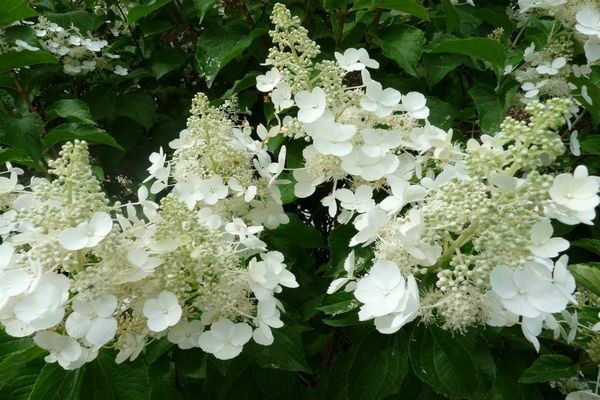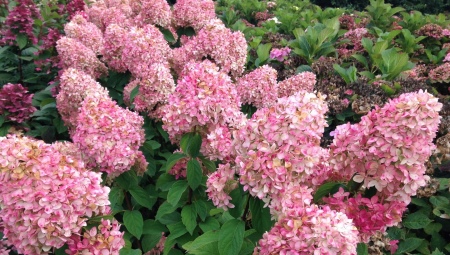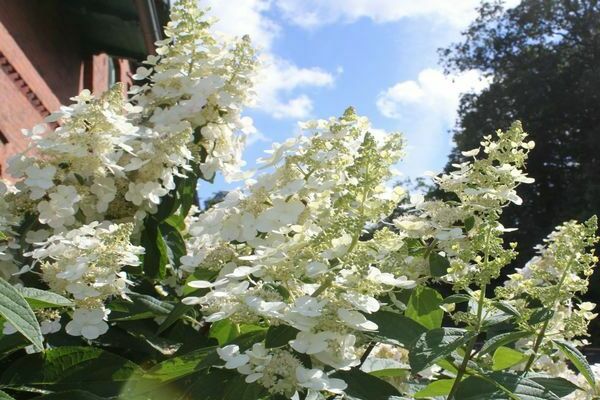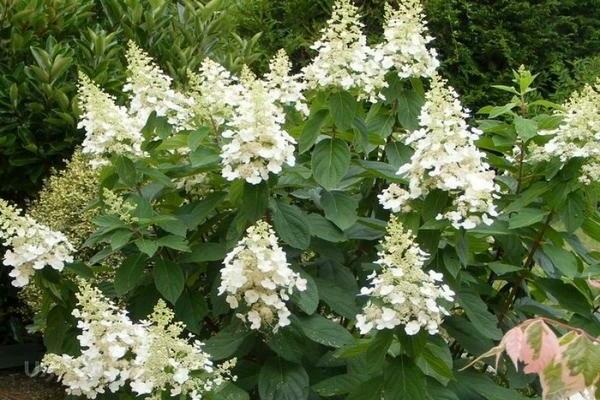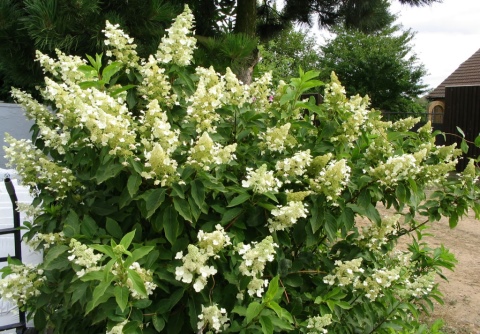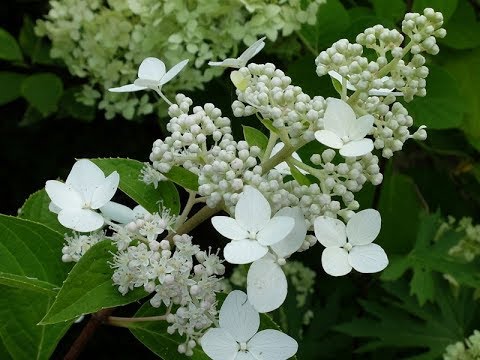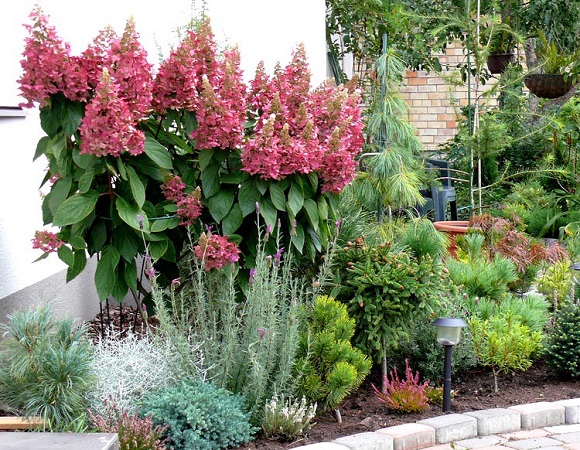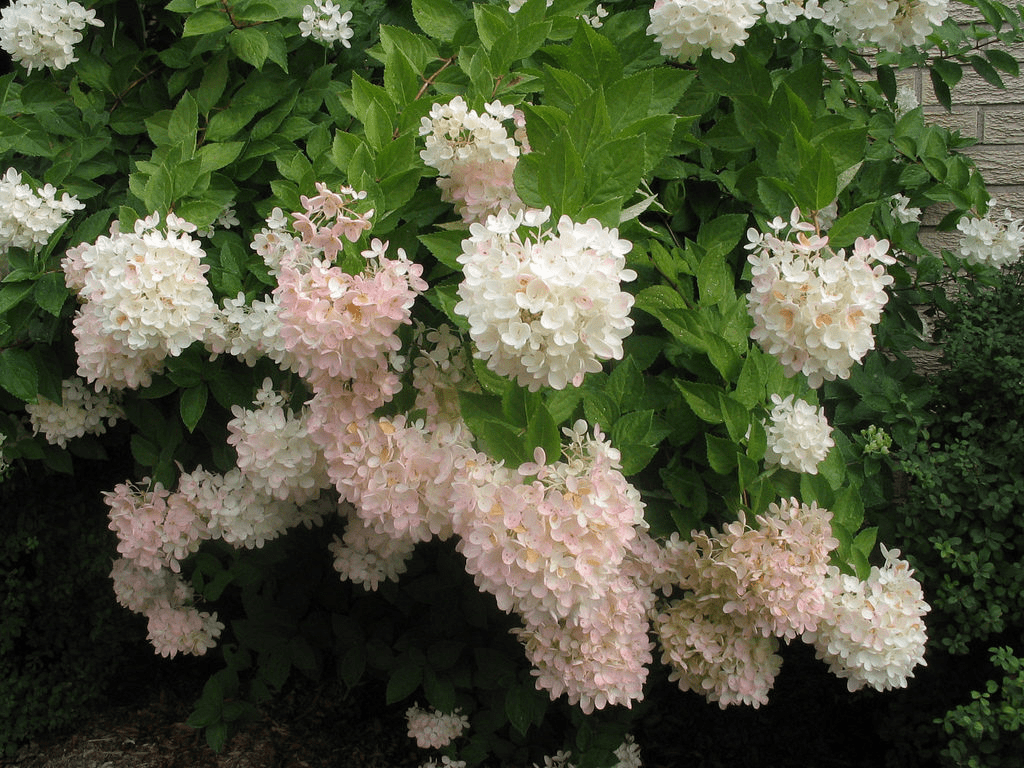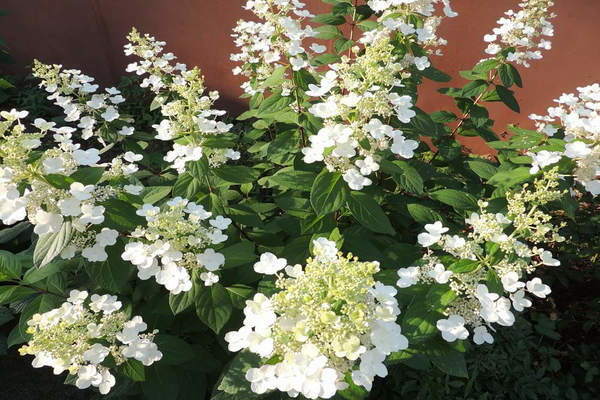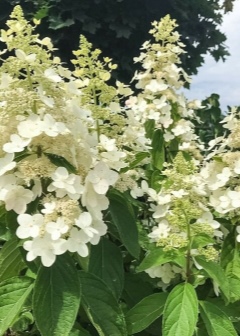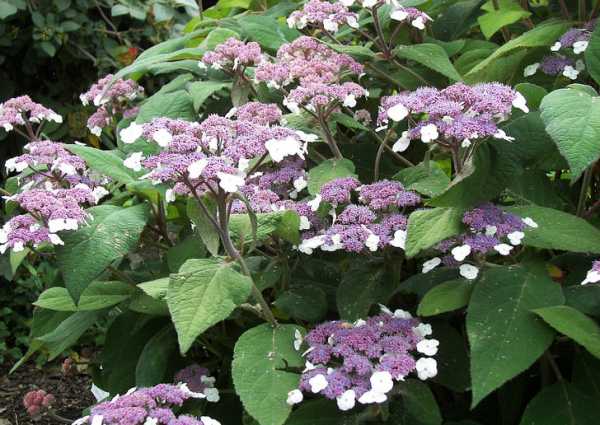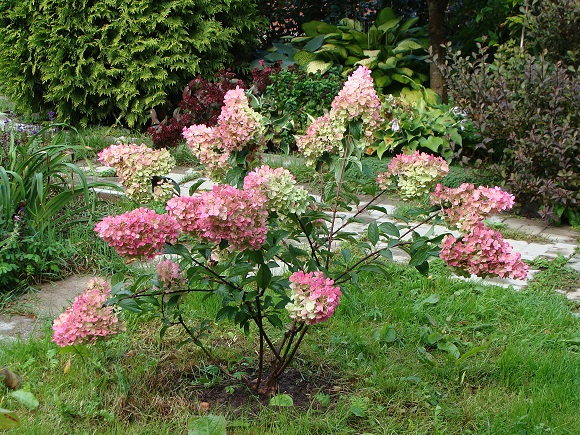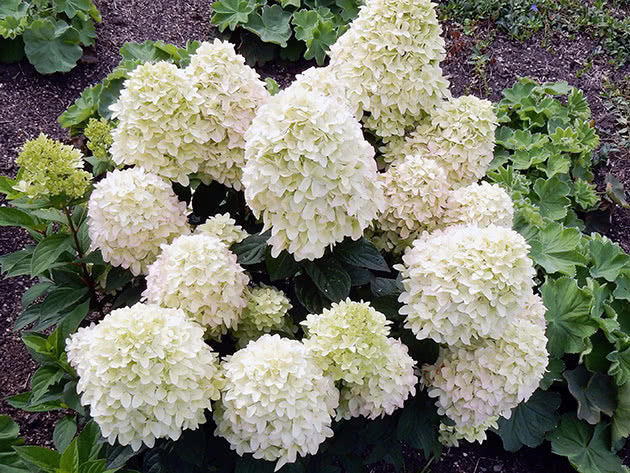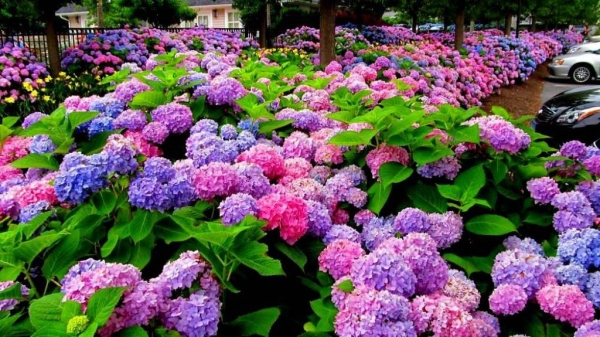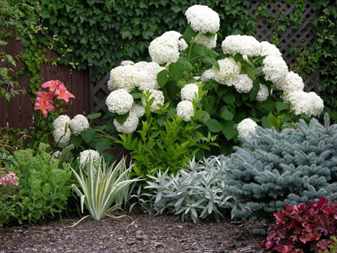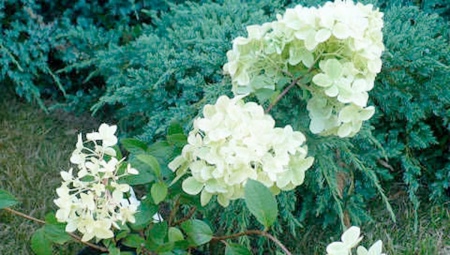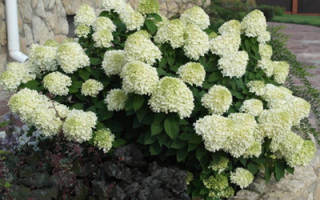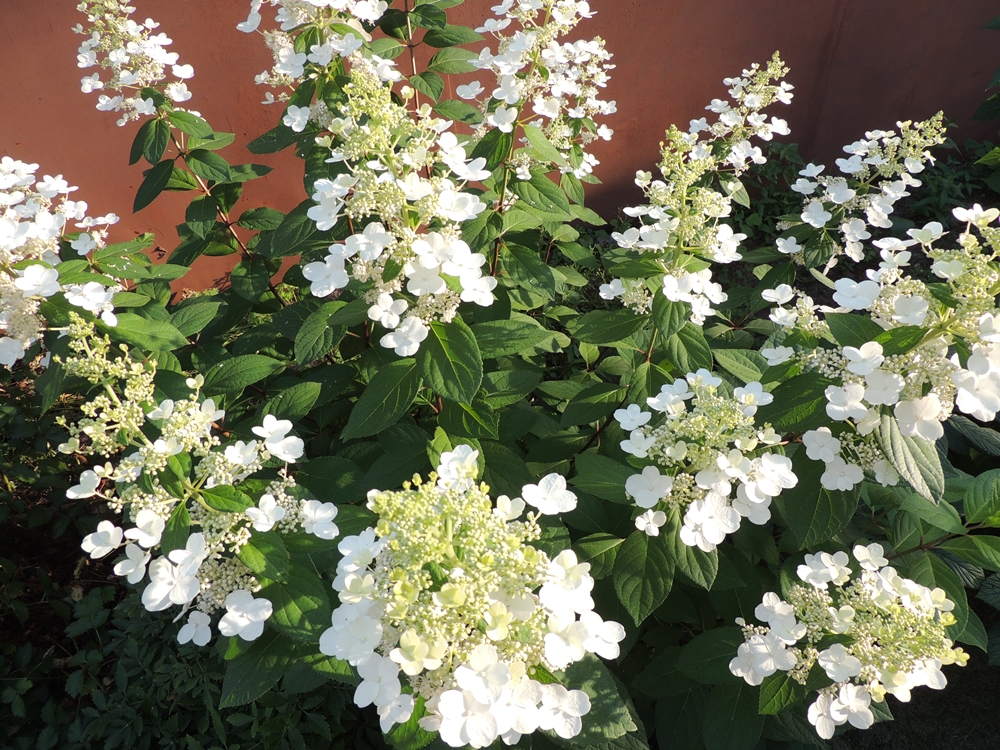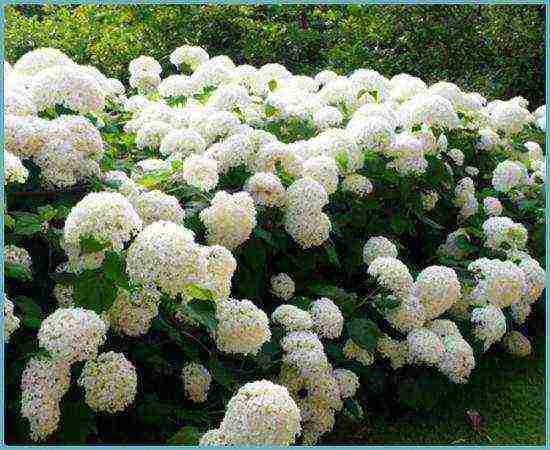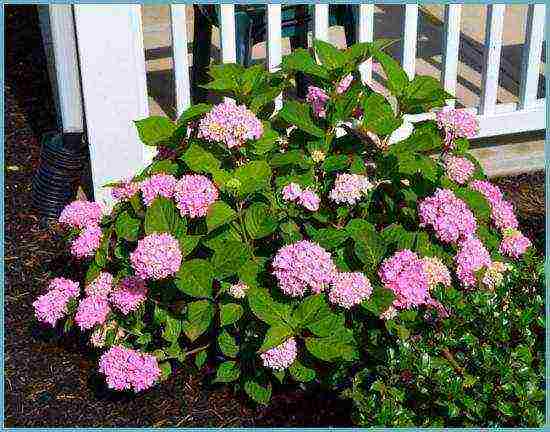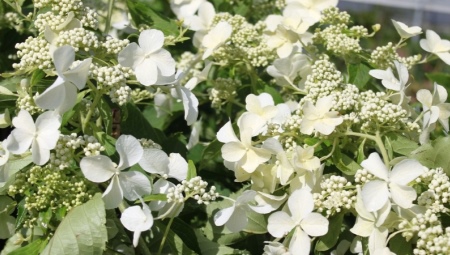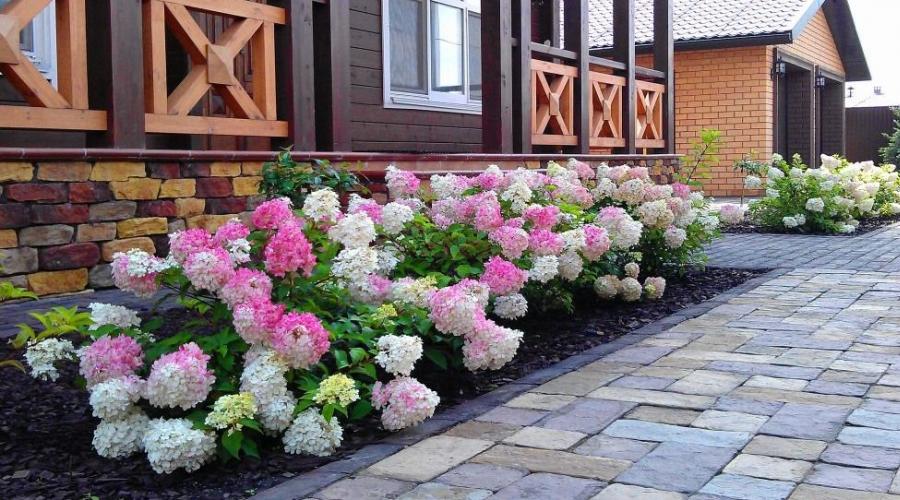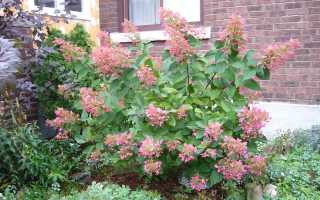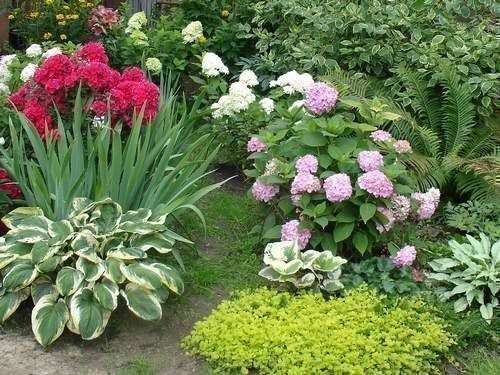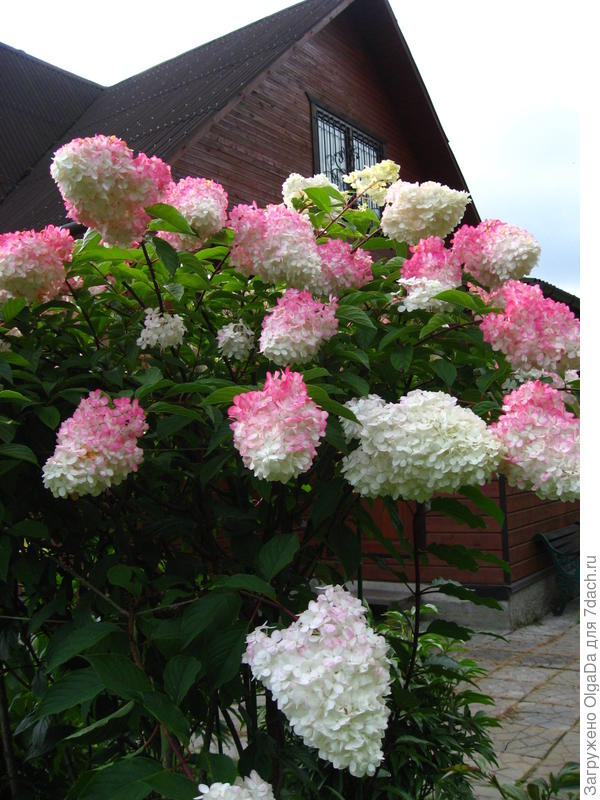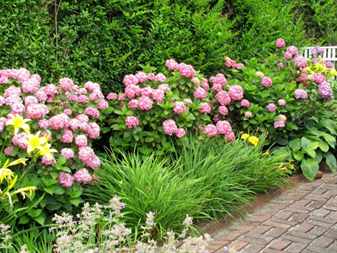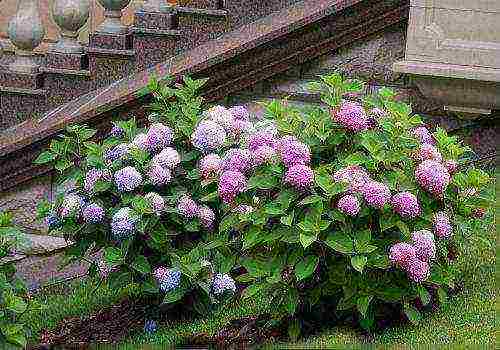White varieties of hydrangea tree
Hydrangea tree variety Annabelle
The most common and well-known variety with large inflorescences up to 25-30 cm in diameter, consisting of sterile flowers up to 2 cm in diameter. The color of the flowers varies from greenish-white to snow-white.
The bush is 1–1.5 m high with a crown up to 3 m in diameter. The crown is round, broadly spreading. Large bright green leaves do not change color in autumn. Blooms from June to September.
in the photo hydrangea tree variety Annabelle (1 - in summer and 2 - in autumn)
The disadvantages of the variety include high sensitivity to soil pH, susceptibility to various kinds of chlorosis and fungal diseases.
Winter and frost resistance of the variety is very high. It grows rapidly, is distinguished by great longevity, life expectancy reaches 50 years.
Hydrangea tree variety Incrediball, Strong Annabelle
The variety differs from Annabelle in even larger spherical or hemispherical inflorescences, globular, creamy white with a slight lime tint. The inflorescences consist of large, sterile flowers. Blooms from mid-late June until frost.
Vigorous bush with very strong shoots that hold inflorescences well even during strong wind and rain. While rainy weather has always been a problem for Annabelle, her flower caps, filled with water, bend to the ground.
An adult bush reaches a height of 1.6-1.8 m. The leaves are large, retain their rich color until late autumn.
Hydrangea tree variety Bounty
A compact variety with a spherical crown, no more than 1.4 m high and up to 1.5 m in diameter. The shoots are quite strong, the leaves are large. Large spherical inflorescences up to 25–35 cm in diameter consist of sterile flowers, when blooming are greenish-white, in full dissolution they are pure white. Blooms profusely from June to August.
In severe winters, it can freeze slightly.
pictured hydrangea tree variety Bounty
Hydrangea tree variety Grandiflora
An old American variety, and, strictly speaking, not even quite a variety, but rather one of the cultivated wild-growing forms, which differs from the usual wild Hydrangea arborescens in larger flowers. Very similar to Annabelle, but with flatter, irregular inflorescences.
A spreading bush up to 1.5 m in height and up to 3 m in diameter. From June to September it blooms with creamy white large inflorescences up to 20 cm in diameter.
Hydrangea tree variety Sterilis
Differs in exceptionally abundant and long flowering. The inflorescences are dense, hemispherical, the branches bend with their weight, consist of sterile flowers, which gradually turn from whitish-green to pure white during the season.
Blooms from July to October. The height of the bush is up to 2 m.
pictured hydrangea tree variety Sterilis
Hydrangea tree variety White Dome, Dardom
Shrub up to 1.4 m high with smooth, thick and strong non-sticking shoots. Inflorescences are numerous, large, creamy white: in the center there are fertile creamy white flowers, along the edge - snow-white sterile.
Abundant flowering in July-August, sometimes delayed until the onset of frost.
Hibernates without shelter. To maintain abundant flowering, more frequent feeding is required than the crop average.
Hydrangea tree variety Hills of Snow
A compact spherical bush up to 1–1.5 m high. The leaves are large, green. Sterile flowers are greenish-white at first, then creamy-white, then white and pinkish by autumn. The inflorescences themselves are hemispherical, medium-sized, 10-15 cm in diameter.
Blooms very profusely in July-September.
In severe winters, it can freeze slightly, but quickly recovers.
Hydrangea tree variety Hayes Starburst, Hovaria Hayes, Sturburst
The dream of almost any landscape designer is the world's first double-flowered variety!
in the photo hydrangea tree variety Hayes Starburst, Hovaria Hayes, Sturburst
The variety is southern in origin, but has good winter hardiness. Recommended for growing throughout the European part of Russia. Shrub up to 1.2-1.3 m high with reddish-brown thin shoots, during flowering require a garter. The green oblong leaves are slightly velvety.Inflorescences are umbrella-shaped, dome-shaped, consist of sterile double flowers, similar to asterisks, initially light greenish, in the period of complete dissolution - white.
Blooms from June to September. It builds up slowly, so be patient when planting. In the third year after planting, the variety will show itself in all its glory.
Hibernates without shelter.
Botanical features of large-leaved hydrangea
Large-leaved hydrangea, or garden (Hydrangea macrophylla) is a highly decorative and fast-growing type of hydrangea native to Japan and China. The maximum height in a region with severe winters is limited to 1-2 m.This species has erect shoots, ovoid, large, bright green leaves and flat wide inflorescences with a diameter of up to 15 cm and a height of up to 10 cm, consisting of fruiting lilac or blue and large pink, with irregular bright strokes, reaching up to 3.5 cm in diameter, sterile flowers.
Hydrangea inflorescences, the flowering of which starts in July, remain highly decorative until next spring: they dry out, but still remain very attractive.
Large-leaved hydrangeas, the fashion for which came to us from the West, so captivating in tubs and pots, so unique in their beauty for their almost spherical dense inflorescences and bright foliage - shrubs are still capricious and unadapted to the harsh climate. But this does not prevent them from growing even in regions with harsh winters.
And although these beauties need special care and protection for the winter, their beauty, nevertheless, is unmatched. And it doesn't matter whether you decide to transplant a potted hydrangea into the garden or originally purchased a garden plant - the principles of growing and caring for the shrub will still be the same. The main difficulty in growing large-leaved hydrangeas is associated with the need to preserve last year's shoots, on which this type of hydrangea blooms, during a long and harsh winter, not only without freezing, but also without damping off.
Reproduction
To breed this shrub, several breeding methods are used:
-
cuttings;
-
dividing the bush;
-
layering.
For the first method, cuttings are harvested in the summer. To do this, cut off young stems that did not have time to lignify. Propagation by cuttings is carried out as follows:
- the cut parts are placed in water for 2-3 days;
- the lower leaves are removed from the cuttings;
- shoots are treated with a preparation to stimulate growth;
- prepared cuttings are planted in a container with soil, which includes peat and sand;
- the container is covered with polyethylene or glass, creating a mini-greenhouse;
- planted cuttings are kept in the basement;
- seedlings need to be moistened periodically;
- at the end of August, the cuttings already have a formed strong root system, and they are quite ready for planting in open soil.
When breeding hydrangeas by division, at the end of flowering, the bush is dug up and divided into several parts, each of which must have at least one growth bud. Then each flower is planted in a separate planting hole with pre-prepared soil. For this, organic matter or mineral dressings are introduced.
With the help of layering, shrubs can only be propagated in the spring season. This method of reproduction is used quite rarely, since the result is not always positive. For him:
- dig a hole 15-20 cm deep near the bush;
- the lower young shoot is placed in the hole and sprinkled with soil;
- water the branch as the soil dries up;
- after the formation of new leaves on the cut, it is separated from the mother plant and planted in a new place.
Hydrangea Tardiva will serve as a real decoration of any site, you just have to pay a little attention and care to it.
You will learn more about planting, caring and pruning hydrangeas below.

